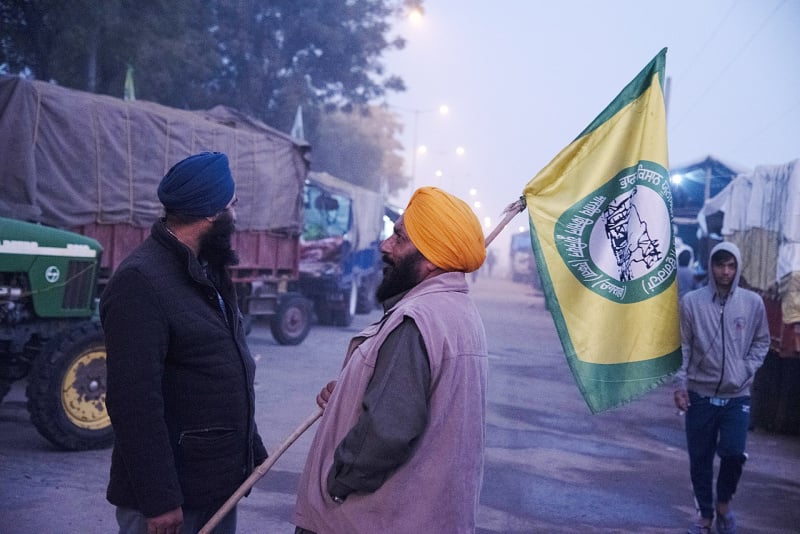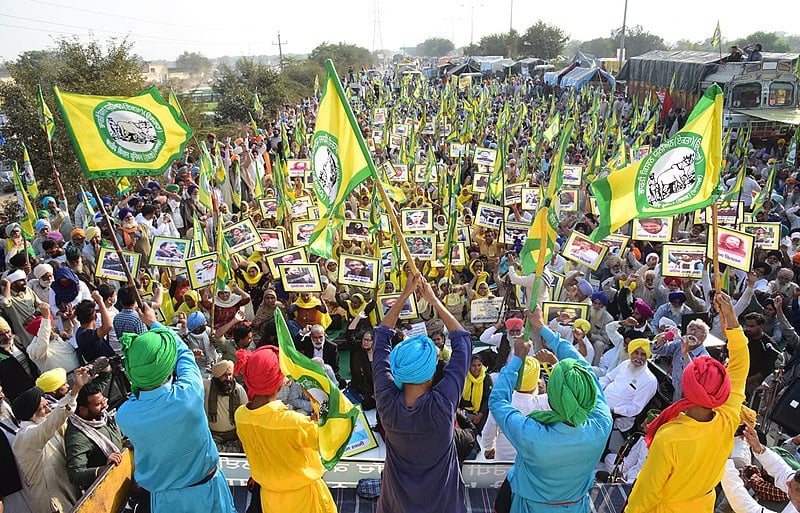How farmers shut down the world's largest democracy
And what you can learn from the movement in India
Feb 23, 2021
By Jon Milton, Communications Staff
"When you attack workers, when you take what they’re entitled to,” says Rashpal Sehmby, a postal worker in Edmonton, “then it sparks an uprising."
Sehmby is talking about his birth-country India, where on November 26, organized farmers kicked off the largest general strike in world history. Workers from trade unions across the country walked off the job for the day and held massive demonstrations. The workers were striking in solidarity with the farmers, and it was one of the early peaks of the farmers movement, which has continued to agitate across the country.
In the time since, the farmers have continued to take direct action. The strike on November 26 was the culmination of the “Dilli Chalo,” which translates to “let’s go to Delhi,” campaign, where farmers from across India—mostly in the Northern regions—descended on the capitol. The border areas surrounding it became the sites of farmer barricades, and the protesters occupied the city, deploying hunger strikes and blockades to pressure the government.
“There are many struggles, whether historical or present, that give us some guidance on what needs to be done when faced with an aggressive government that’s using the power of the state to push an ideological agenda.”
It’s possible to draw similarities here in Alberta to what’s happening in India,” Guy Smith says. “You have a very aggressive government pushing an ideological agenda to privatize and corporatize the public social fabric that supports every community in Alberta. This, combined with the attack on citizen rights to protest and to fight back means that we need to continue working hard to build a level of resistance similar to what we are seeing in India.”
“There are many struggles, whether historical or present, that give us some guidance on what needs to be done when you’re faced with a very aggressive government that’s using the power of the state to push this ideological agenda,” Smith says. “We also have many members of Indian descent, who have very strong connections to what is happening in their home country. They must be very concerned about the level of violence and oppression.”

With the Indian parliament under the domination of his extreme right-wing Bharatiya Janata Party (BJP), Prime Minister Narendra Modi’s government announced in September 2020 that it would be overhauling the farming system in India
“These bills weren’t favouring the rights of farmers. They’re attacking those rights,” says Varinder Bhullar, an activist in Edmonton who supports the farmers. “The government wants to get rid of the MSP, the Minimum Standard Price.”
As a program that allows farmers to sell certain crops such as wheat and rice, to the government at a minimum price, the MSP guarantees a livable income. Under the BJP reforms, large corporations to buy crops without any price guarantees. Once corporations control the market, farmers say they expect for crop prices to drop significantly, reducing farmers decent living to miserable exploitation.
“Another part is that farmers can’t even take those big corporations to the courts. They have to go to this committee, or this sub-committee,” Bhullar says. “Guess who those committees favour? The corporations.”
“Once the farmers realized their livelihood was under attack, they realized that their land would be taken from them by the corporations, they all decided to move,” Bhullar says. “They started a movement.”

Organizing against the farm reforms began to take hold most heavily in Punjab, the northern province that is home to most of the world’s Sikh population. It’s also the country’s breadbasket.
“The history of the Sikhs is one where we laugh at the tyrants who try to destroy us,” says Rashpal Sehmby. “That collective action is entrenched within us as almost a religious conviction.”
Having been born in Punjab and moved to Canada as a child, Sehmby today is a postal worker in Edmonton who’s running for city council in Ssopmitapi, formerly known as Ward 12. He’s been monitoring the situation closely in India and participating in solidarity demonstrations here in Edmonton. While the Indian situation is different than Alberta’s in important ways, it still offers several critical lessons.

Lesson #1: Start with your co-workers and neighbors
In Punjab, farmers began by organizing amongst themselves as soon as the government announced the reforms. After meetings within their farmers’ unions, they started organizing their communities, which became the nucleus of a broader movement which rapidly spread across the entire country.
For Guy Smith, this process has parallels to the union’s organizing strategy.
“I’ve been a union activist for 35 years,” he says. “The most important thing that a union activist can do, whether they’re steward at the worksite or the union president, is to foment discussions on the shop floor.”
That’s the type of local organizing, Smith says, that allows for the union to build up capacity to challenge the agenda of the UCP—whose plan to privatize public services has parallels with the Indian government’s plans to corporatize farming.
Smith says that shopfloor organizing builds up strength and confidence among workers and prepares them to fight back on a broader scale. It’s impossible for workers to take on the government’s entire anti-worker agenda, and to fight to save jobs and services, he says, without having that confidence—and those relationships of trust with fellow workers.
“When you attack the livelihood of people, you have two choices: you either... allow them to continue to destroy pensions, destroy jobs, or you stand up,” Sehmby says. “It should be a really good learning instrument for unions across the world. Do you sit back and do nothing, or do you start small and build outwards?”

Lesson #2: Want to scare the government? Show them you’ve got support
Once they organized locally, the farmers in Punjab and the surrounding regions expanded their drive.
“What started as a small movement grew larger,” Sehmby says. “There is now 14 or so unions involved, and they’re crippling the movement of goods across the country—the truckers union has joined in too.”
For Bhullar, expansion is indispensable for victory. “Initially, the movement was in only two provinces—Punjab and Haryana,” he says. “But as the masses started getting out to other provinces, that’s when the government started to get worried. Because even if they lose those two provinces, they can still form government... That’s how all governments think,” he says. “That’s how they do their calculations.”
At AUPE, Smith says that the union is building a united front with other unions and organizations in Alberta, but there remains a lot of work to be done.
“Much of our emphasis has been on our own members, rightly so,” Smith says. “But we also recognize that to build a broader movement, there has to be that connection, that support and solidarity for other organizations that are feeling the weight of this government.”
“Along with other unions, I would like to see us build much stronger relationships with other non-labour organizations,” Smith says.
“Indigenous rights groups, human rights groups, ethnic groups. When we had things like the Idle No More movement, or Indigenous land rights movements, yes, we’ve been there, but I’d like to see us be there shoulder to shoulder.”
“If AUPE is serious about fighting and creating a network of organizing, you need to create a web—with AUPE at the centre, but with other unions and organizations,” Sehmby says. “I’m one of those people who believes that the only way to get governments to listen to us is to take direct action.”

Lesson #3: Direct Action Gets the Goods
After the general strike, and the blockades around Delhi, the government began to feel the heat. They announced a newfound willingness to negotiate. So that the government could launch new consultations, the Supreme Court of India even temporarily suspended the farm reforms. “Farmers don’t trust the supreme court,” Bhullar says, “so they suggested to the government that they repeal the law.” Continuing to occupy the streets, the farmers kept up their pressure.
Guy Smith sees parallels to AUPE’s strategy here in Alberta. For one, he says, the union is fully committed to members engaging in direct action.
“Our 2019 convention unanimously passed a resolution to support members who organize themselves to take direct action,” Smith says.
“This is the perspective that I’ve based my decades of activism on, and I’m very encouraged that direct action has been adopted and endorsed as the key focus and strategy of the union overall.”
Smith says that the union is focused on direct action because it helps workers build confidence, skills, solidarity and capacity to engage in struggle at the worksite and on a larger scale.”
“Much like with the struggles in India we also cannot rely solely on the courts,” Smith says. “There’s no guarantee we’ll be successful, and even if we are, then it can take a very long time, potentially years. By then, the damage is done, Kenney has laid waste to our rights.”
Of course, AUPE continues to challenge unjust laws and restrictions using the courts, but Smith says that it can’t be the only way forward.
“The only real response is collective direct action, regardless of how it’s being restricted.”“The direct action,” Sehmby says, “the civil disobedience shown by the farmers in India—that’s the only route you can go if you want to win.”
We have heard comments about calling a general strike, but you can’t just call a general strike. You have to build it."
No Shortcuts to Building a Movement
To win against an ideologically driven government like the one in Alberta right now—or against the one in India—there are a few important lessons. All of them boil down to one word: organize.
To build a strong movement, we need to build strong relationships with our fellow workers and community members. We need to have relationships of trust, where we know that we can depend on one another when we take risks. There are no shortcuts to building those relationships, or to building a movement that’s capable of winning.
“It’s hard work,” Smith says. “You’re dealing with people’s fears of the unknown, fear of backlash, but we have to be honest with workers about how the only way to we’re going to overcome these struggles is by doing so collectively, and by taking risks.”
“We have heard comments about calling a general strike, but you can’t just call a general strike,” Smith says. “You have to build it—conversation by conversation, worker by worker, worksite by worksite, and community by community.”